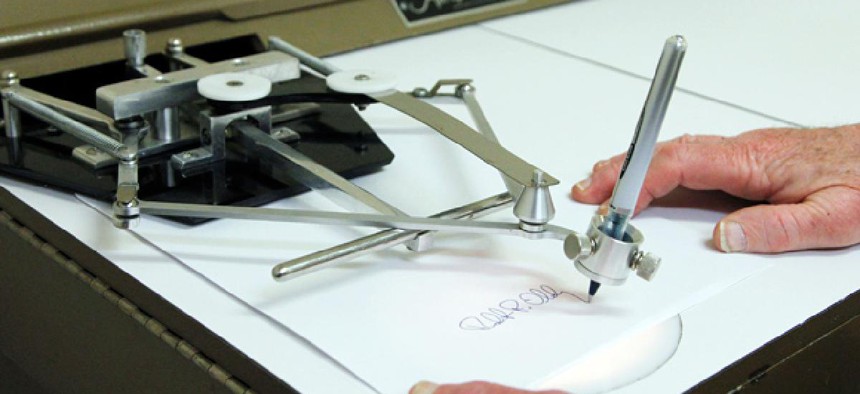
Manuel Balce Ceneta/AP
When a robot signs a bill: A brief history of the autopen
The machine has been used by presidents from Jefferson to Obama.
While serving as the 3rd president of the United States, Thomas Jefferson discovered a piece of technology that he could simply not live without. And no, it wasn't this thoroughly gonzo precursor to the home gym.
It was the polygraph (shown on the right): a machine that made direct copies of handwritten letters. The user would write a version on one side of the machine, and by mechanical action, the words would be instantly facsimiled on the other. Being the technophile that he was, Thomas Jefferson purchased two: one for the White House, one for Monticello.
In 1809, he wrote to the portrait artist Charles Wilson Peale raving that "the use of the polygraph has spoiled me for the old copying press the copies of which are hardly ever legible. . . . I could not, now therefore, live without the Polygraph."
As it turns out, neither can modern-day presidents.
Yesterday, the president was in Hawaii, rejoining his family on vacation. The recently passed fiscal-cliff deal was in Washington. How could the all important-presidential signature be affixed to the bill to make it law? The solution: Obama signed it via a robot, the autopen, a technological great, great grandchild of the machine Jefferson so loved.
Although the White House won't tell you how it works, the device essentially makes a copy of the president's pen strokes and saves them in the system's memory for future facsimile. Typically, any pen or pencil can be loaded into the machine. It has been reported that George W. Bush prefered Sharpies.
Citing ambiguity in the Constitution (the exact line is "if he approve he shall sign it"), George W. Bush's Justice Department made the legal case that an autopen is as good as the president's hand when it comes to signing bills.
"Neither the constitutional text nor the drafting and ratification debates provide further guidance regarding what it means for the President to 'sign' a bill he approves," the opinion begins, and then dives into a lengthy legal discussion of what "signing" meant during the early days of the republic (it's a thrilling read with many footnotes).
Although Bush set up the legal argument for autopen bill signing, he never used the device to enact legislation. Obama was the first to do so, signing an extension of the PATRIOT Act via autopen while in Europe. (Kind of fitting that a robot re-signed into law an act that represents the tenuous nature of technology, privacy, and the role of government.) Some lawmakers objected to the move, but no serious legal challenge to auto-signing bills has ever surfaced.
While Jefferson's polygraph could only make copies if he was writing an orignial, fully robotized auto pens didn't arrive until the 1930s. A 1936 article in Popular Science described how the machine recorded a signature on "a master record, comparable to a phonograph,"and was transcribed by a "secret process" to make it difficult to steal one's signature. There was even a function to scramble the recording, rendering the machine useless for a would-be signature thief. (Modern machines store signatures on SD cards.) Harry Truman is said to be the first U.S. president to use such a robotized machine.
The White House treats the presidential autopen's security with the secrecy you might expect for the most powerful signature in the world. "I always heard the autopen was the second-most guarded thing in the White House after the president," Jack Shock, Bill Clinton's director of presidential letters and messages told the Associated Press in 2011. When the AP pressed the matter to the executive branch, the White House "declined to provide any further details about how many autopens the administration uses, what they look like, where they're kept, or who makes the machine."
While there was no signing ceremony for the fiscal cliff legislation, here's how it probably happened.







